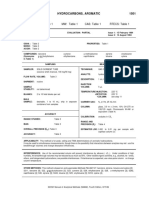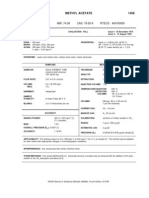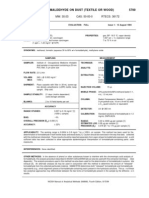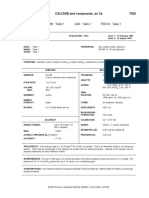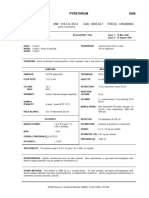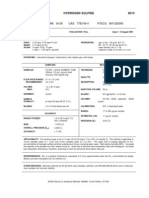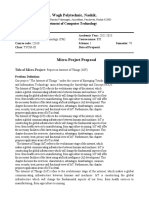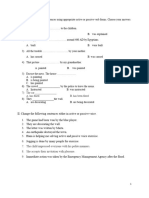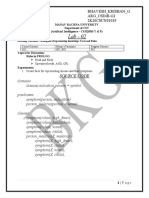Table 1 MW: Table 1 Cas: Table 1 Rtecs: Table 1: Ketones Ii 1301
Table 1 MW: Table 1 Cas: Table 1 Rtecs: Table 1: Ketones Ii 1301
Uploaded by
Nicolas ZeballosCopyright:
Available Formats
Table 1 MW: Table 1 Cas: Table 1 Rtecs: Table 1: Ketones Ii 1301
Table 1 MW: Table 1 Cas: Table 1 Rtecs: Table 1: Ketones Ii 1301
Uploaded by
Nicolas ZeballosOriginal Title
Copyright
Available Formats
Share this document
Did you find this document useful?
Is this content inappropriate?
Copyright:
Available Formats
Table 1 MW: Table 1 Cas: Table 1 Rtecs: Table 1: Ketones Ii 1301
Table 1 MW: Table 1 Cas: Table 1 Rtecs: Table 1: Ketones Ii 1301
Uploaded by
Nicolas ZeballosCopyright:
Available Formats
KETONES II 1301
TABLE 1 MW: TABLE 1 CAS: Table 1 RTECS: Table 1
METHOD: 1301, Issue 2 EVALUATION: FULL Issue 1: 15 February 1984
COMPOUNDS (3) and (5): PARTIAL Issue 2: 15 August 1994
OSHA/NIOSH/ACGIH: Table 1 PROPERTIES: Table 1
COMPOUNDS: (1) camphor (3) 5-methyl-3-heptanone (5) ethyl butyl ketone
(Synonyms (2) mesityl oxide (4) methyl-(n-amyl)-ketone
in Table 1)
SAMPLING MEASUREMENT
SAMPLER: SOLID SORBENT TUBE TECHNIQUE: GAS CHROMATOGRAPHY, FID
(coconut shell charcoal, 100 mg/50 mg)
ANALYTE: compounds above
FLOW RATE: 0.01 to 0.2 L/min
DESORPTION: 1 mL 1% methanol in CS 2; stand in 30
VOL-MIN: 1L min
-MAX: 25 L
INJECTION VOLUME: 5 µL
SHIPMENT: routine
COLUMN: stainless steel (3 m x 3-mm ID), 10%
SAMPLE FFAP on 80/100 Chromosorb W-AW
STABILITY: unknown
TEMPERATURE-INJECTOR: 200 °C
FIELD BLANKS: 2 to 10 field blanks per set -DETECTOR: 300 °C
-COLUMN: 100 to 200 °C
@ 10 °C/min
CARRIER GAS: N 2 or He, 30 mL/min
ACCURACY
CALIBRATION: standard solutions of analyte in elution
RANGE STUDIED: see EVALUATION OF METHOD solvent
BIAS: see EVALUATION OF METHOD RANGE AND PRECISION: see EVALUATION OF METHOD
OVERALL PRECISION (ŜrT): see EVALUATION OF ESTIMATED LOD: 0.05 mg per sample
METHOD
ACCURACY: see EVALUATION OF METHOD
APPLICABILITY: This method was developed to give better desorption than obtainable with carbon disulfide extraction of the
charcoal. This method can be used in paint and resin manufacturing plants.
INTERFERENCES: None reported. Alternate columns, e.g., 4 m 10% SP-2100/0.1% Carbowax 1500 on Supelcoport 100/120
or DB-1 fused silica capillary may be used.
OTHER METHODS: This method combines and replaces Methods S10, S12, S13, S15 and S16 [1].
NIOSH Manual of Analytical Methods (NMAM), Fourth Edition, 8/15/94
KETONES II: METHOD 1301, Issue 2, dated 15 August 1994 - Page 2 of 5
REAGENTS: EQUIPMENT:
1. Eluent: Carbon disulfide* (chromatographic 1. Sampler: glass tube, 7 cm long, 6-mm OD,
grade) with 1% (v/v) methanol 4-mm ID, flame-sealed ends, containing two
(chromatographic grade). sections of 20/40 mesh activated (600 °C)
2. Analytes, reagent grade. coconut shell charcoal (front = 100 mg; back
3. Nitrogen, prepurified. = 50 mg) separated by a 2-mm urethane foam
4. Hydrogen, dry. plug. A silylated glass wool plug precedes the
5. Air, filtered. front section and a 3-mm urethane foam plug
follows the back section. Pressure drop
across the tube must be less than 3.4 kPa at
* See SPECIAL PRECAUTIONS. the sampling flow rate. Tubes are
commercially available.
2. Personal sampling pump, 0.02 to 0.2 L/min,
with flexible connecting tubing.
3. Gas chromatograph, FID, integrator and
column (page 1301-1).
4. Vials, 2-mL glass, PTFE-lined crimp caps.
5. Syringe, 10-µL, readable to 0.1 µL.
6. Pipet, 1-mL, with pipet bulb.
7. Volumetric flasks, 10-mL.
SPECIAL PRECAUTIONS: Carbon disulfide is toxic and an acute fire and explosion hazard (flash point
= -30 °C); all work done with it must be performed in a fume hood.
SAMPLING:
1. Calibrate each personal sampling pump with a representative sampler in line.
2. Break the ends of the sampler immediately before sampling. Attach sampler to personal
sampling pump with flexible tubing.
3. Sample at an accurately known flow rate between 0.01 and 0.2 L/min for a total sample size of
1 to 25 L.
4. Cap the samplers with plastic (not rubber) caps and pack securely for shipment.
SAMPLE PREPARATION:
5. Place the front and back sorbent sections of the sampler in separate vials. Discard the glass
wool and foam plugs.
6. Add 1.0 mL eluent to each vial. Attach crimp cap to each vial.
7. Allow to stand 30 min with occasional agitation.
CALIBRATION AND QUALITY CONTROL:
8. Calibrate daily with at least five working standards over the range 0.01 to 0.5 mg camphor; and
0.05 to 5 mg of the other analytes per sample.
a. Add known amounts of analyte to eluent in 10-mL volumetric flasks and dilute to the mark.
b. Analyze together with samples and blanks (steps 11 and 12).
c. Prepare calibration graph (peak area vs. mg analyte).
9. Determine desorption efficiency (DE) at least once for each batch of charcoal used for sampling
in the calibration range (step 8). Prepare three tubes at each of five levels plus three media
blanks.
NIOSH Manual of Analytical Methods (NMAM), Fourth Edition, 8/15/94
KETONES II: METHOD 1301, Issue 2, dated 15 August 1994 - Page 3 of 5
a. Remove and discard back sorbent section of a media blank sampler.
b. Inject a known amount of analyte directly onto front sorbent section with a microliter syringe.
c. Cap the tube. Allow to stand overnight.
d. Desorb (steps 5 through 7) and analyze together with working standards (steps 11 and 12).
e. Prepare a graph of DE vs. mg analyte recovered.
10. Analyze three quality control blind spikes and three analyst spikes to insure that the calibration
graph and DE graph are in control.
MEASUREMENT:
11. Set gas chromatograph according to manufacturer's recommendations and to conditions given
on page 1301-1. Inject sample aliquot manually using solvent flush technique or with
autosampler.
NOTE: If peak area is above the linear range of the working standards, dilute with CS 2,
reanalyze, and apply the appropriate dilution factor in calculations.
12. Measure peak area.
CALCULATIONS:
13. Determine the mass, mg (corrected for DE) of analyte found in the sample front (W f) and back
(W b) sorbent sections, and in the average media blank front (B f) and back (B b) sorbent
sections.
NOTE: If W b > W f/10, report breakthrough and possible sample loss.
14. Calculate concentration, C, of analyte in the air volume sampled, V (L):
EVALUATION OF METHOD:
Laboratory testing with spiked samples and samples collected from atmospheres generated by syringe
pump/air dilution and verified by FID continuous monitor [2]. Results were:
S/A
Breakthrough 1
Range Overall
Method (mg per Range Precision Bias Accuracy
Compound [1,2] sample) DE 2- Sr (mg/m 3) (L) ŜrT (%) (±%)
Camphor S10 0.02 to 0.40 0.97 0.018 6 to 25 >48 0.074 0.9 10.5
Mesityl oxide S12 0.10 to 3.0 0.81 0.014 45 to 210 >48 0.071 7.0 22.8
5-Methyl-3-heptanone S13 0.15 to 4.0 0.90 0.014 60 to 270 >36 0.10 13.1 31.0
Methyl-(n-amyl)-ketone S15 0.5 to 10.0 0.82 0.012 200 to 925 >36 0.066 4.9 15.0
Ethyl butyl ketone S16 0.25 to 7.0 0.94 0.022 100 to 460 >24 0.086 -3.1 26.3
1
5% breakthrough, 0.2 L/min at high end of concentration range in dry air.
2
Averaged over mass range shown.
NIOSH Manual of Analytical Methods (NMAM), Fourth Edition, 8/15/94
KETONES II: METHOD 1301, Issue 2, dated 15 August 1994 - Page 4 of 5
REFERENCES:
[1] NIOSH Manual of Analytical Methods, 2nd. ed., V. 2, S10, S12, S13 and S15, S16, U.S.
Department of Health, Education, and Welfare, Publ. (NIOSH) 77-157-B (1977).
[2] Documentation of the NIOSH Validation Tests, S10, S12, S13 and S15, S16, U.S. Department of
Health, Education, and Welfare, Publ. (NIOSH) 77-185 (1977).
METHOD REVISED BY:
Ardith Grote, NIOSH/DPSE; methods originally validated under NIOSH Contract CDC-99-74-45.
NIOSH Manual of Analytical Methods (NMAM), Fourth Edition, 8/15/94
KETONES II: METHOD 1301, Issue 2, dated 15 August 1994 - Page 5 of 5
TABLE 1. GENERAL INFORMATION
Exposure Limits, ppm
Compound
(Synonyms) ACGIH
CAS Formula TLV mg/m 3/ppm
RTECS (M.W.) OSHA NIOSH STEL @NTP
Camphor C10H16O 2 2 2 6.22 ;d2
d9
im
9Ll/.o
g
0s@ C;° 52
(CAS #76-22-2) (152.24) 3 ;C4°M
P2
V
0
8aP
14k7
.1
0
.0
RTECS EX1225000 mmm H
;m
g/g0741
Mesityl oxide CH 3COCH=C(CH 3)2; C 6H10O 25 10 15 4.01 ;dP
Biu
9q
21
;Ci°P
V1l .aP
1k
(4-methyl-3-penten-2-one) (98.15) 25 8(m L2;2/8d
)ggH
.0
(CAS #141-79-7)
RTECS SB4200000
5-Methyl-3-heptanone CH 3CH 2COCH 2CH(CH 3)- 25 25 25 5.00 ;dP
Biu9q51
;C
i°P
V
72
laP.k0
(Ethyl amyl ketone) CH 2CH 3; C 8H16O -- 2(m L2;2/8d
)ggH
.0
(CAS #541-85-5) (122.22)
RTECS MJ7350000
Methyl-(n-amyl)-ketone CH 3CO(CH 2)4CH 3; C 7H14O 100 100 50 4.67 ;dP
Biu1q51;C
i°P
V
7l2aP.k0
(2-Heptanone) (114.19) 2(m L0;2/8d
)ggH
.0
(CAS #110-43-0)
RTECS MJ5075000
Ethyl butyl ketone CH 3CH 2CO(CH 2)3CH 3; C 7H14O 50 50 50 4.67 ;dP
Biu8
q41
;C
i°P
V
35
laP.k0
(3-heptanone) (114.19) 4(m L8;1/8d
)ggH
.0
(CAS #106-35-4)
RTECS MJ5250000
*NOTE: All densities and vapor pressures are at 20 °C unless stated otherwise.
NIOSH Manual of Analytical Method (NMAM), Fourth Edition, 8/15/94
You might also like
- NIOSH 0500-1994 (Total Dust As Inhalable Dust)Document4 pagesNIOSH 0500-1994 (Total Dust As Inhalable Dust)apriliandiniNo ratings yet
- Acetona Niosh 1300 PDFDocument5 pagesAcetona Niosh 1300 PDFOscar Garcia GutierrezNo ratings yet
- NISOH 1401 ButanolDocument4 pagesNISOH 1401 Butanolluis norabuenaNo ratings yet
- NIOSH 1550 NaftasDocument6 pagesNIOSH 1550 NaftaspetrolinkinNo ratings yet
- Table 1 MW: Table 1 CAS: Table 2 RTECS: Table 2: Alcohols I 1400Document4 pagesTable 1 MW: Table 1 CAS: Table 2 RTECS: Table 2: Alcohols I 1400Cristian Gutiérrez PeñaNo ratings yet
- Niosh 1501Document7 pagesNiosh 1501Lucas OliveiraNo ratings yet
- Niosh 1610Document3 pagesNiosh 1610tio dameroNo ratings yet
- CH CHCH CL MW: 76.53 CAS: 107-05-1 RTECS: UC7350000: Allyl Chloride 1000Document3 pagesCH CHCH CL MW: 76.53 CAS: 107-05-1 RTECS: UC7350000: Allyl Chloride 1000Cristian Gutiérrez PeñaNo ratings yet
- Niosh 2555Document5 pagesNiosh 2555KayceePortsNo ratings yet
- Niosh 1609Document3 pagesNiosh 1609MICROLABORATORIO S.A de C.VNo ratings yet
- Niosh 1450Document6 pagesNiosh 1450MICROLABORATORIO S.A de C.VNo ratings yet
- Cloruro de MetilenoDocument4 pagesCloruro de MetilenoLuisa MinaNo ratings yet
- Niosh 1612Document4 pagesNiosh 1612MICROLABORATORIO S.A de C.VNo ratings yet
- Formulas: Table 1 MW: Table 1 Cas: Table 1 Rtecs: Table 1: Ketones Ii 2553Document4 pagesFormulas: Table 1 MW: Table 1 Cas: Table 1 Rtecs: Table 1: Ketones Ii 2553Nicolas ZeballosNo ratings yet
- NIOSH Manual of Analytical Methods - 1501Document7 pagesNIOSH Manual of Analytical Methods - 1501Eng Wanders MillerNo ratings yet
- NIOSH 1457-1994 Ethyl Acetate Udara Lingker GC FIDDocument4 pagesNIOSH 1457-1994 Ethyl Acetate Udara Lingker GC FIDFakhri MuflihNo ratings yet
- Niosh 1500Document8 pagesNiosh 1500MICROLABORATORIO S.A de C.VNo ratings yet
- Methyl AcetateDocument3 pagesMethyl AcetatetranhungNo ratings yet
- Hydrocarbons, AromaticDocument7 pagesHydrocarbons, AromaticestebanNo ratings yet
- Niosh 1403Document5 pagesNiosh 1403MICROLABORATORIO S.A de C.VNo ratings yet
- Niosh 1610Document4 pagesNiosh 1610MICROLABORATORIO S.A de C.VNo ratings yet
- Niosh 1405Document6 pagesNiosh 1405MICROLABORATORIO S.A de C.VNo ratings yet
- Niosh 5523Document5 pagesNiosh 5523MICROLABORATORIO S.A de C.VNo ratings yet
- Plastificanti Come DOPDocument5 pagesPlastificanti Come DOPMarco CorrengiaNo ratings yet
- Niosh Methanol 2000Document4 pagesNiosh Methanol 2000Endang MilahNo ratings yet
- Descripcion MetodoDocument4 pagesDescripcion MetodoAaron HernandezNo ratings yet
- Niosh 2500 Metil Etil Cetona (Mek)Document4 pagesNiosh 2500 Metil Etil Cetona (Mek)EverChumpisucaAlvarezNo ratings yet
- Nmam 2027Document7 pagesNmam 2027MICROLABORATORIO S.A de C.VNo ratings yet
- TOLUENE (Diffusive Sampler) 4000: C H CH MW: 92.14 CAS: 108-88-3 RTECS: XS5250000Document4 pagesTOLUENE (Diffusive Sampler) 4000: C H CH MW: 92.14 CAS: 108-88-3 RTECS: XS5250000VaninaNo ratings yet
- Niosh 1606Document3 pagesNiosh 1606MICROLABORATORIO S.A de C.VNo ratings yet
- Yodo - NIOSH 6005Document4 pagesYodo - NIOSH 6005Mario LagosNo ratings yet
- 1600 PDFDocument4 pages1600 PDFHarold Alonso CFNo ratings yet
- Al MW: 26.98 (Al) CAS: 7429-90-5 (Al) RTECS: BD0330000 101.96 (Al 0) 1344-28-1 (Al 0) BD1200000Document4 pagesAl MW: 26.98 (Al) CAS: 7429-90-5 (Al) RTECS: BD0330000 101.96 (Al 0) 1344-28-1 (Al 0) BD1200000Huu Thanh NguyenNo ratings yet
- CH C H Oh MW: 108.14 Cas: 1319-77-3 Rtecs: Go5950000 C H Oh 94.11 108-95-2 SJ3325000Document4 pagesCH C H Oh MW: 108.14 Cas: 1319-77-3 Rtecs: Go5950000 C H Oh 94.11 108-95-2 SJ3325000HectorNo ratings yet
- Niosh 1018-1 - ClorodifluormetanoDocument4 pagesNiosh 1018-1 - Clorodifluormetanosolucao.hoNo ratings yet
- Niosh 6004 Dióxido de AzufreDocument4 pagesNiosh 6004 Dióxido de AzufreEverChumpisucaAlvarezNo ratings yet
- (CH O) SO MW: 126.13 CAS: 77-78-1 RTECS: WS8225000: Dimethyl Sulfate 2524Document4 pages(CH O) SO MW: 126.13 CAS: 77-78-1 RTECS: WS8225000: Dimethyl Sulfate 2524Fauzan FebriyantoNo ratings yet
- Niosh Method 1501Document7 pagesNiosh Method 1501Memet ganashpatiNo ratings yet
- Hydrocarbons, Halogenated 1003: Table 1 MW: Table 2 Cas: Table 1 Rtecs: Table 1Document7 pagesHydrocarbons, Halogenated 1003: Table 1 MW: Table 2 Cas: Table 1 Rtecs: Table 1api-3728640No ratings yet
- Volatile Organic Compounds, C1 To C10, Canister Method: Formula: Table 1 MW: Table 1 CAS: Table 1 RTECS: Table 1Document14 pagesVolatile Organic Compounds, C1 To C10, Canister Method: Formula: Table 1 MW: Table 1 CAS: Table 1 RTECS: Table 1Karly RodriguezNo ratings yet
- CH (CH) NH MW: 73.16 CAS: 109-73-9 RTECS: EO2975000: N-Butylamine 2012Document4 pagesCH (CH) NH MW: 73.16 CAS: 109-73-9 RTECS: EO2975000: N-Butylamine 2012Jayesh PanjabiNo ratings yet
- Table 1 MW: Table 1 CAS: Table 2 RTECS: Table 2: Alcohols I 1400Document4 pagesTable 1 MW: Table 1 CAS: Table 2 RTECS: Table 2: Alcohols I 1400cerbero36No ratings yet
- NIOSH 5026 Oil MistDocument3 pagesNIOSH 5026 Oil MistSanti KertatiNo ratings yet
- Niosh 6009 PDFDocument5 pagesNiosh 6009 PDFCaleb ConnerNo ratings yet
- Formaldehyde On Dust (Textile or Wood) 5700: H C O MW: 30.03 CAS: 50-00-0 RTECS: 36172Document5 pagesFormaldehyde On Dust (Textile or Wood) 5700: H C O MW: 30.03 CAS: 50-00-0 RTECS: 36172alexdruppiNo ratings yet
- Niosh Method 1501-Hc GC B IndoDocument8 pagesNiosh Method 1501-Hc GC B IndoMemet ganashpatiNo ratings yet
- 7906 FLUORIDES Aerosol and Gas, by IC: F MW: 18.998 CAS: (HF) 7664-39-3 RTECS: (HF) MW7875000Document4 pages7906 FLUORIDES Aerosol and Gas, by IC: F MW: 18.998 CAS: (HF) 7664-39-3 RTECS: (HF) MW7875000sonecuNo ratings yet
- Niosh 2554 PDFDocument4 pagesNiosh 2554 PDFMICROLABORATORIO S.A de C.VNo ratings yet
- NIOSH 2549 - Compuestos Orgánicos Volátiles PDFDocument8 pagesNIOSH 2549 - Compuestos Orgánicos Volátiles PDFNoe Adrianzen MNo ratings yet
- Ca MW: Table 1 CAS: Table 1 RTECS: Table 1: CALCIUM and Compounds, As Ca 7020Document4 pagesCa MW: Table 1 CAS: Table 1 RTECS: Table 1: CALCIUM and Compounds, As Ca 7020Harold Alonso CFNo ratings yet
- C H O Toc H O MW: 316.4 To 372.4 Cas: 8003-34-7 Rtecs: Ur4200000Document4 pagesC H O Toc H O MW: 316.4 To 372.4 Cas: 8003-34-7 Rtecs: Ur4200000Boss VinaNo ratings yet
- NIOSH 7900 Arsenico As PDFDocument3 pagesNIOSH 7900 Arsenico As PDFNicolas ZeballosNo ratings yet
- Niosh 7301 PDFDocument8 pagesNiosh 7301 PDFAngelicaNo ratings yet
- 2542 Metil Merkaptan Metil SulideDocument4 pages2542 Metil Merkaptan Metil SulideEndang WahyulNo ratings yet
- Niosh 6013Document4 pagesNiosh 6013Frank OspinaNo ratings yet
- Allyl Chloride 1000: CH CHCH CL MW: 76.53 CAS: 107-05-1 RTECS: UC7350000Document3 pagesAllyl Chloride 1000: CH CHCH CL MW: 76.53 CAS: 107-05-1 RTECS: UC7350000Luis TrejoNo ratings yet
- NIOSH 8310 Ed 94 Metales en OrinaDocument5 pagesNIOSH 8310 Ed 94 Metales en OrinaMario Rodrigo Ramirez MesaNo ratings yet
- Niosh 6010Document5 pagesNiosh 6010Mai Trung ToànNo ratings yet
- CTM 036 TDI EmisionesDocument8 pagesCTM 036 TDI EmisionesNicolas ZeballosNo ratings yet
- Método 9036 Sulfato (Azul Metiltimol)Document7 pagesMétodo 9036 Sulfato (Azul Metiltimol)Nicolas ZeballosNo ratings yet
- NIOSH 7400 AsbestosDocument40 pagesNIOSH 7400 AsbestosNicolas ZeballosNo ratings yet
- NIOSH 7900 Arsenico As PDFDocument3 pagesNIOSH 7900 Arsenico As PDFNicolas ZeballosNo ratings yet
- Formulas: Table 1 MW: Table 1 Cas: Table 1 Rtecs: Table 1: Ketones Ii 2553Document4 pagesFormulas: Table 1 MW: Table 1 Cas: Table 1 Rtecs: Table 1: Ketones Ii 2553Nicolas ZeballosNo ratings yet
- ICSE Class 6 Geography Sample Paper Set 1Document4 pagesICSE Class 6 Geography Sample Paper Set 1dipayanrcNo ratings yet
- Using Deep Learning To Enhance Cancer Diagnosis and ClassificationDocument8 pagesUsing Deep Learning To Enhance Cancer Diagnosis and ClassificationEndy PranotoNo ratings yet
- Gravity Wave Drag: Unified Model Documentation Paper 022Document18 pagesGravity Wave Drag: Unified Model Documentation Paper 022Reno ChoiNo ratings yet
- 50x SeriesDocument24 pages50x Seriesxpress editionNo ratings yet
- Thuvienhoclieu.com Bo 5 de on Tap Cuoi HK1 Anh 11 Global 24 25Document108 pagesThuvienhoclieu.com Bo 5 de on Tap Cuoi HK1 Anh 11 Global 24 25Qúy TrầnNo ratings yet
- History of Industrial and Organizational PsychologyDocument2 pagesHistory of Industrial and Organizational PsychologyMariccon Celestial Palma100% (2)
- DisinfectionDocument528 pagesDisinfectionrajtanniruNo ratings yet
- Proposal ETIDocument3 pagesProposal ETIAditi moreNo ratings yet
- Carpentry and Estimates Module 2021Document108 pagesCarpentry and Estimates Module 2021Chrisha Jane LanutanNo ratings yet
- Active and Passive Voice ExerciseDocument2 pagesActive and Passive Voice Exercisehalakeabduba14No ratings yet
- A Review On Abrasive Wear Mechanisms of Metallic MaterialsDocument13 pagesA Review On Abrasive Wear Mechanisms of Metallic MaterialsLoJi MaLoNo ratings yet
- 5. UPPER REVISION FINAL I (2024-2025) (1)Document2 pages5. UPPER REVISION FINAL I (2024-2025) (1)tuyetle.vietlongNo ratings yet
- NSTPDocument18 pagesNSTPNessa BautistaNo ratings yet
- Orifices and Mouth PiecesDocument8 pagesOrifices and Mouth PiecesDavid KegayaNo ratings yet
- Frequency Distributions and Graphs: Objective 1Document13 pagesFrequency Distributions and Graphs: Objective 1Muhammad Adnan KhalidNo ratings yet
- Adaptation and MitigationDocument33 pagesAdaptation and MitigationAMIT100% (1)
- Lime and Dolomite For The Steel IndustryDocument8 pagesLime and Dolomite For The Steel IndustrychmsarfrazNo ratings yet
- Kant's Fourth ParalogismDocument27 pagesKant's Fourth ParalogismAnonymous pZ2FXUycNo ratings yet
- Rayence 1417WCC WGC없음-1-1Document2 pagesRayence 1417WCC WGC없음-1-1Adi SukmaNo ratings yet
- Peh DLL 7TH WKDocument2 pagesPeh DLL 7TH WKRheena-Ann Dupale PadillaNo ratings yet
- Statistical Physics (MSC Phy) 4Document7 pagesStatistical Physics (MSC Phy) 4SACHIN VISHWAKARMANo ratings yet
- Final Written Proposal Template For Nursing Research1Document14 pagesFinal Written Proposal Template For Nursing Research1Mart Juaresa Yambao100% (8)
- (George Ware) Reviews of Environmental Contaminati (BookFi)Document307 pages(George Ware) Reviews of Environmental Contaminati (BookFi)Rizqiana Halim100% (1)
- Bhavesh Krishan Garg Cse4b-G1 (Ai Lab - 02)Document9 pagesBhavesh Krishan Garg Cse4b-G1 (Ai Lab - 02)Bhavesh GargNo ratings yet
- GE 2 ACTIVITY SHEET MODULE 3 CopyDocument10 pagesGE 2 ACTIVITY SHEET MODULE 3 CopyZONETTE PAREDONo ratings yet
- Unit-2: Operations On Single Random VariablesDocument11 pagesUnit-2: Operations On Single Random VariablesHarini VemulaNo ratings yet
- Grids and CoordinatesDocument27 pagesGrids and Coordinatesapi-247725573No ratings yet
- Techop (D-01 - Rev1 - Jan21) Addressing C3ei2 To Eliminate Single Point FailuresDocument133 pagesTechop (D-01 - Rev1 - Jan21) Addressing C3ei2 To Eliminate Single Point FailuresAnatoliy SavelyevNo ratings yet
- Get RektDocument16 pagesGet RektandreaspiposNo ratings yet
- AI Algorithms Explained To KidsDocument20 pagesAI Algorithms Explained To Kidsalexovapa1No ratings yet





